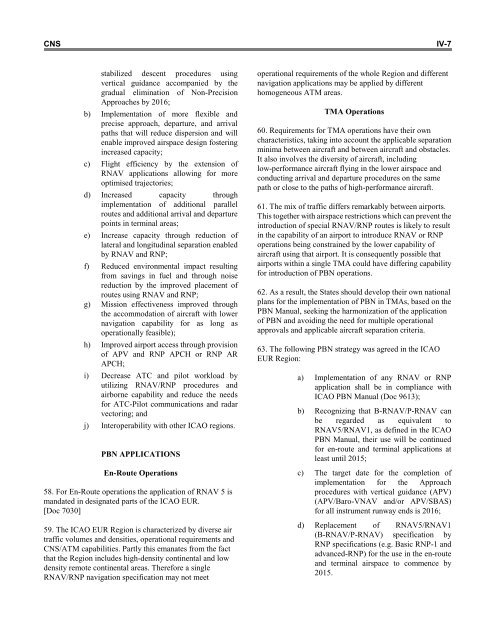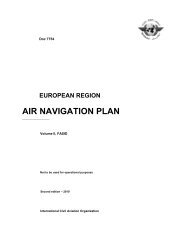7754 Vol 1 Flyleaf - ICAO Public Maps
7754 Vol 1 Flyleaf - ICAO Public Maps
7754 Vol 1 Flyleaf - ICAO Public Maps
Create successful ePaper yourself
Turn your PDF publications into a flip-book with our unique Google optimized e-Paper software.
CNS IV-7<br />
stabilized descent procedures using<br />
vertical guidance accompanied by the<br />
gradual elimination of Non-Precision<br />
Approaches by 2016;<br />
b) Implementation of more flexible and<br />
precise approach, departure, and arrival<br />
paths that will reduce dispersion and will<br />
enable improved airspace design fostering<br />
increased capacity;<br />
c) Flight efficiency by the extension of<br />
RNAV applications allowing for more<br />
optimised trajectories;<br />
d) Increased capacity through<br />
implementation of additional parallel<br />
routes and additional arrival and departure<br />
points in terminal areas;<br />
e) Increase capacity through reduction of<br />
lateral and longitudinal separation enabled<br />
by RNAV and RNP;<br />
f) Reduced environmental impact resulting<br />
from savings in fuel and through noise<br />
reduction by the improved placement of<br />
routes using RNAV and RNP;<br />
g) Mission effectiveness improved through<br />
the accommodation of aircraft with lower<br />
navigation capability for as long as<br />
operationally feasible);<br />
h) Improved airport access through provision<br />
of APV and RNP APCH or RNP AR<br />
APCH;<br />
i) Decrease ATC and pilot workload by<br />
utilizing RNAV/RNP procedures and<br />
airborne capability and reduce the needs<br />
for ATC-Pilot communications and radar<br />
vectoring; and<br />
j) Interoperability with other <strong>ICAO</strong> regions.<br />
PBN APPLICATIONS<br />
En-Route Operations<br />
58. For En-Route operations the application of RNAV 5 is<br />
mandated in designated parts of the <strong>ICAO</strong> EUR.<br />
[Doc 7030]<br />
59. The <strong>ICAO</strong> EUR Region is characterized by diverse air<br />
traffic volumes and densities, operational requirements and<br />
CNS/ATM capabilities. Partly this emanates from the fact<br />
that the Region includes high-density continental and low<br />
density remote continental areas. Therefore a single<br />
RNAV/RNP navigation specification may not meet<br />
operational requirements of the whole Region and different<br />
navigation applications may be applied by different<br />
homogeneous ATM areas.<br />
TMA Operations<br />
60. Requirements for TMA operations have their own<br />
characteristics, taking into account the applicable separation<br />
minima between aircraft and between aircraft and obstacles.<br />
It also involves the diversity of aircraft, including<br />
low-performance aircraft flying in the lower airspace and<br />
conducting arrival and departure procedures on the same<br />
path or close to the paths of high-performance aircraft.<br />
61. The mix of traffic differs remarkably between airports.<br />
This together with airspace restrictions which can prevent the<br />
introduction of special RNAV/RNP routes is likely to result<br />
in the capability of an airport to introduce RNAV or RNP<br />
operations being constrained by the lower capability of<br />
aircraft using that airport. It is consequently possible that<br />
airports within a single TMA could have differing capability<br />
for introduction of PBN operations.<br />
62. As a result, the States should develop their own national<br />
plans for the implementation of PBN in TMAs, based on the<br />
PBN Manual, seeking the harmonization of the application<br />
of PBN and avoiding the need for multiple operational<br />
approvals and applicable aircraft separation criteria.<br />
63. The following PBN strategy was agreed in the <strong>ICAO</strong><br />
EUR Region:<br />
a) Implementation of any RNAV or RNP<br />
application shall be in compliance with<br />
<strong>ICAO</strong> PBN Manual (Doc 9613);<br />
b) Recognizing that B-RNAV/P-RNAV can<br />
be regarded as equivalent to<br />
RNAV5/RNAV1, as defined in the <strong>ICAO</strong><br />
PBN Manual, their use will be continued<br />
for en-route and terminal applications at<br />
least until 2015;<br />
c) The target date for the completion of<br />
implementation for the Approach<br />
procedures with vertical guidance (APV)<br />
(APV/Baro-VNAV and/or APV/SBAS)<br />
for all instrument runway ends is 2016;<br />
d) Replacement of RNAV5/RNAV1<br />
(B-RNAV/P-RNAV) specification by<br />
RNP specifications (e.g. Basic RNP-1 and<br />
advanced-RNP) for the use in the en-route<br />
and terminal airspace to commence by<br />
2015.














